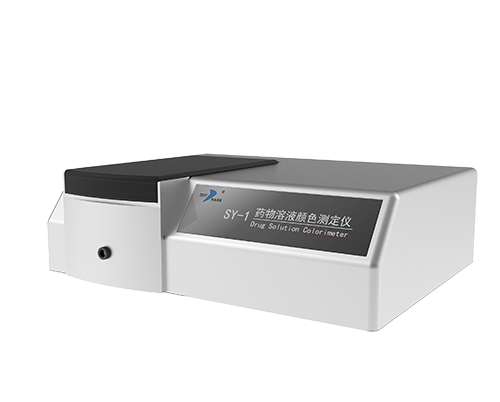Technical advantages of SY-1 drug solution color tester
SY-1 drug solution color tester adopts the principle of spectral measurement. Patented technology ensures measurement stability and accuracy. It is equipped with color measurement software dedicated to drug solutions and has a built-in "Chinese Pharmacopoeia" standard colorimetric solution color database. It can quickly give the closest hue and color number of the sample in the "Chinese Pharmacopoeia" standard colorimetric solution, and measure color and color difference more quickly, accurately and quantitatively.

The following are the technical advantages of the SY-1 drug solution colorimeter:
Measurement principle and light source advantages
- Adopting the spectral measurement principle, its full-band balanced LED composite light source (CLEDs) avoids the spectral loss of white light LED in a specific band, which can improve the instrument's measurement speed and the accuracy of the measurement results.
- Dual-path spectral analysis technology can simultaneously obtain the reflection signal and light source intensity signal of the measured sample, and compensate for the light source error through black and white calibration after startup, ensuring the accuracy and long-term stability of the instrument's measurement.
Performance parameter advantages
- **Good stability**: The RSD of the total color difference △E* in 6 hours is ≤1%, which can ensure the accuracy and reliability of long-term measurement and is suitable for drug solution detection with high requirements for color stability.
- **High linearity**: In the range of 0.5-10 for each color standard colorimetric solution, the linear correlation coefficient r of the total color difference △E* is better than 0.999, and there is a good linear relationship between the measurement result and the standard value, which can more accurately perform quantitative analysis of the color of the drug solution.
- **High resolution**: It can identify at least 1/10 of the color difference of the adjacent color number of the standard colorimetric solution, accurately distinguish solutions with similar colors, and can also keenly capture the subtle changes in the color of the drug solution, which helps to more precisely control the quality of the drug.
- **Small inter-instrument difference**: The RSD of the total color difference △E* is ≤2%, and the consistency of the measurement results between multiple instruments is good. The data measured by different instruments can be compared and referenced with each other, which can ensure the accuracy and comparability of the data in large-scale drug production and quality control.
- **Good repeatability**: The RSD of the total color difference △E* is ≤1%. When the same instrument measures the same drug solution multiple times, the repeatability of the measurement results is high, which can improve the credibility of the measurement data and the repeatability of the experimental results.
Software and database advantages
- Equipped with color measurement software dedicated to pharmaceutical solutions, it has a built-in 2015 edition of the Chinese Pharmacopoeia standard colorimetric solution color database, which can quickly give the closest hue and color number of the sample in the Chinese Pharmacopoeia standard colorimetric solution, and can add the European Pharmacopoeia standard colorimetric solution database according to user needs, realizing the color conversion between the European Pharmacopoeia and the Chinese Pharmacopoeia standard colorimetric solutions, meeting the requirements of the third method (colorimeter method) of the solution color inspection method in the 2015 edition of the Chinese Pharmacopoeia General Chapter 0901 of the 2015 edition of the Chinese Pharmacopoeia, providing a strong basis and convenient operation for the color detection and quality control of pharmaceutical solutions.
Operation and display advantages
- The software interface is friendly and easy to operate. It can intuitively display the position of the test sample color in the three-dimensional chromaticity space, the chromaticity coordinate value, the color deviation compared with the standard colorimetric solution, and other information, so that the operator can fully understand the color characteristics of the drug solution and facilitate the analysis and interpretation of the measurement results.
Technical parameters:
Light source: Full-band balanced LED composite light source (CLEDs), including the commonly used standard light sources D65 and C in pharmacopoeia
Lighting mode: 0/0 (vertical irradiation, vertical reception)
Observer angle: 2°/10°
Measurement wavelength range: 400~700nm
Wavelength interval: 10nm
Sensor: Dual optical path array sensor
Measurement aperture: about 10mm
Color measurement liquid addition amount: not less than 1.5ml
Measurement time: 0.5 seconds
Measurement interval time: 2 seconds
Absolute error of measuring the three stimulus values X, Y, Z of pure water: ≤0.1
2024-12-27 11:10
- Related News
Automatic Cross-Hatch Tester | PV 3952, Ford BN 108-03,GM N 14688 Compliant
Multi-Finger Scratch/Mar Tester | Automotive Plastics & Interior Materials T
Dental Material Color Stability Tester | ISO 4049 / YY 0270 / ASTM G155 Complian
Masks Bacterial Filtration Efficiency (BFE) Tester | YY 0469 / ASTM F2100 / BS E
Smoke Density Tester | ASTM E662 / ISO 5659-2 Compliant
Dry Microbial Penetration Resistance Tester | ISO 22612 / YY/T 0506.5
Dry Fallen Wadding Tester — YY/T 0506.6 | ISO 9073-10 | EN 13795-2
Fogging Tester | Automotive Interior Volatile Fogging Test System
